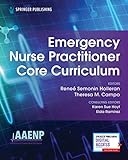Emergency Nurse Practitioner Core Curriculum
Material type: TextPublication details: New York Springer Publishing 2022ISBN:
TextPublication details: New York Springer Publishing 2022ISBN: - 9780826141255
- WY 154.2
| Item type | Current library | Shelving location | Call number | Status | Date due | Barcode | Item holds | |
|---|---|---|---|---|---|---|---|---|
 General Book
General Book
|
Kuakarun Nursing Library | Shelving Cart | WY 154.2 H457 2022 (Browse shelf(Opens below)) | Available | 0000047313 |
Foundations of practice --- History of the emergency nurse practitioner --- Fundamental clinical skills (neonatal, pediatric, and adult) --- Diagnostic and therapeutic procedures --- Evidence-based research and publication --- Clinical decision-making --- Emergency resuscitation and stabilization --- Pain management --- Leadership, team dynamics, and communication --- Ethics, bioethics, and legal aspects of emergency care --- Organ donation --- Complementary and alternative modalities in the emergency department --- Part II. Medical emergencies. 12. Head, eyes, ears, nose, and throat --- The neurologic patient --- Thoracic/respiratory urgencies and emergencies --- Cardiovascular medical emergencies --- Vascular medical emergencies --- Medical emergencies of the stomach, esophagus, and duodenum --- Renal, genitourinary, and reproductive conditions --- Metabolic and endocrine conditions --- Inflammatory and immunologic conditions --- Hematologic and oncologic emergencies --- Infectious diseases --- Psychiatric and mental health emergencies --- Part III. Shock and trauma. 24. Shock: cardiogenic, hypovolemic, neurogenic, septic, toxic --- Multisystem trauma --- Head trauma and brain injuries --- Spinal injuries --- Neck injuries --- Abdominal trauma --- Genitourinary trauma --- Peripheral vascular injuries --- Orthopedic injuries --- Soft tissue injuries --- Part IV. Environmental emergencies --- Frostbite and nonfreezing cold injuries --- Heat-related emergencies --- Lightning and electrical injuries --- Scuba diving and dysbarism --- Altitude injuries and conditions --- Drowning injuries --- Radiation injuries --- Part V. Toxicology, overdose management, substance use disorder --- Approach to the poisoned patient --- Toxicology --- Poisoning by other toxins --- Substance use disorder --- Part VI. Emergency medical services, patient transport, and disaster preparedness --- Emergency medical services --- Patient transfer and transport --- Crisis and disaster management --- Chemical and biological weapons --- Part VII. Special patient populations. --- The pregnant patient --- The pediatric patient --- The geriatric patient --- Rural/austere patient population --- Sexual and gender minority patients in the emergency department --- Vulnerable populations in the emergency setting --- Victims of violence: interpersonal violence, intimate partner violence, and sexual assault --- Palliative and end-of-life care
There are no comments on this title.

